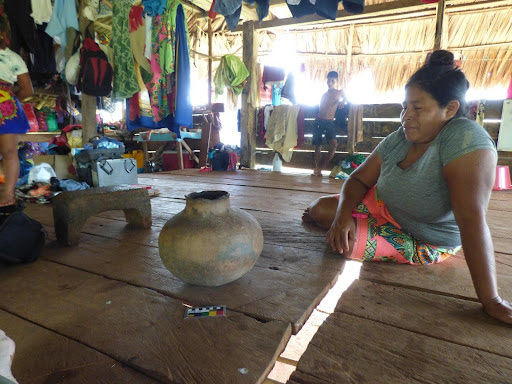
Indigenous Sociopolitics
One of my collaborators, Doña Bélgica, wearing a traditional Emberá skirt and carrying a pail of water. The thatched roof houses in the background are traditional constructions, made of multiple types of local plants. The houses are elevated so that animals can be stored underneath them and so that the area can be used for chores that might be too dirty to carry out inside.

Vocabulary
Petroglyph:
A rock art image created by removing part of the surface of the rock through carving or grinding.
Descendant community:
Living people whose ancestors created or had an important relationship with an archaeological site. Descendant communities are one type of stakeholder.
Oral history:
Stories that impart information about historical events and are passed down verbally from generation to generation. These stories often contain Traditional Ecological Knowledge and other place-specific information.
Sociopolitics:
How communities organize their social (family, relationships) and political (decision-making and governance) systems. These can range from more hierarchical to more egalitarian, more patriarchal to more matriarchal, etc.
Mola:
Traditional textile made by Guna craftspeople, usually women, who stitch together layers of brightly-colored fabrics and then cut them using applique techniques. The word means bird plumage in the Guna language, and these textiles are traditionally made into blouses and worn by Guna women. They often depict geometric patterns, as well as animals and plants.
While working with the Emberá community of Mogué, community members introduced me to two different archaeological sites: La Mola and Quebrada Seca.
Both of these sites are located within the contemporary territory of this Emberá community (although they don’t have a legal title to this land – something they are working on, which archaeology might be helpful for). However, they are very different from each other: La Mola is a boulder carved with petroglyphs, with little other material culture, located far away from any natural resources. Quebrada Seca, which means “dry creek”, is a more typical settlement site, located on a river, where people were making ceramics and stone tools, hunting, fishing, and collecting water.
The layout of the ~1000-year-old agricultural fields at Quebrada Seca is also similar to those that the village uses today, which might imply that there are similarities in sociopolitical structure. Today, the village of Mogué is managed by a cooperative system – no one owns the land, and the village council determines how much land each family is responsible for cultivating and maintaining. The fields are subdivided based on the number of families and their allotments. Unless we have written information in addition to archaeological data about a society, it can be very difficult to figure out how the power structure of a society is organized (Who was in charge? Were there established socioeconomic classes, or was the society more egalitarian? Did people own land, and how was that decided?). Archaeologists typically look for evidence of power and hierarchy by excavating burials and looking at whether some people are buried with more or fancier objects than others. However, many communities do not want scientists to dig up their ancestors, and this desire should be respected. Also, merely establishing whether or not inequality existed does not tell us much about how the society actually functioned. Therefore, working with descendant communities to reconstruct these systems is crucial.
As you can see in this photo of Quebrada Seca, the water level of the creek is low, which might explain why the community no longer cultivates this area. As they plan future land uses, the community is interested in learning about how climate change has impacted (and will impact) different areas of their territory in different ways.or example, why have some areas flooded, while others have become drier?, so this is a very interesting question for future archaeological study.
Unlike Quebrada Seca, the Emberá community of Mogué does not recognize La Mola as an ancestral site. They maintain a path to it through the forest and visit it regularly, but they did not create it. Rather, they named it La Mola because it was created by the Guna people, who today mostly live on the Caribbean coast of Panama, on the opposite side of the country. The Guna are famous for their handmade multicolored textiles, called molasin the Guna language. Today, they are made with fabric, but in pre-Hispanic times these traditional motifs were painted on the body and drawn on other media – including this stone boulder.
Based on Emberá oral history and information from historic documents, Mogué was never the ancestral territory of the Guna, but they had negotiated certain hunting, fishing, and trading rights with the Emberá, and this boulder was carved as a representation of the relationship between these communities. The Emberá people of Mogué maintain it today because they recognize the continued importance of this relationship. If you look closely at this boulder, you can see human figures, a geometric spiral, and a river, all iconographic motifs that are common in molas crafted today by the Guna.




